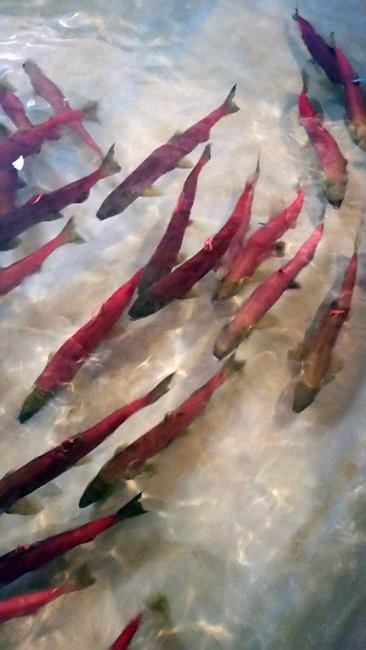
This undated photo provided by Idaho Fish and Game shows Snake River sockeye salmon that returned from the Pacific Ocean to Idaho over the summer swim in a holding tank on Tuesday, Sept. 26, 2017, at the Idaho Department of Fish and Game's Eagle Fish hatchery in southwestern Idaho. The number of the endangered fish that made it back this year is the second worst in the last decade but there are enough hatchery-raised fish to make up for the bad return. (Dan Baker/ Idaho Fish and Game via AP)
September 27, 2017 - 12:59 PM
BOISE, Idaho - The number of imperiled Snake River sockeye salmon that made it back to central Idaho this year is the second worst in the last decade, officials said, but enough hatchery-raised fish exist to keep a state and federal recovery program going.
The Idaho Department of Fish and Game said Tuesday that 159 of the federally protected fish arrived at the Sawtooth Basin near Stanley as of Monday after travelling 900 miles (1,400 kilometres) from the Pacific Ocean.
That's below the 10-year average of 690 but not bad considering biologists estimated only about 400 started the journey at Bonneville Dam, the first of eight dams the fish must pass on the Columbia and Snake rivers before reaching the Salmon River.
Sockeye salmon are a prized sport fish and the Idaho run is culturally important to the Shoshone-Bannock Tribes, which have worked to restore habitat. An estimated 150,000 sockeye at one time returned annually to central Idaho, and Redfish Lake was named for the abundant red-colored salmon that spawned there.
Federal officials say the run declined starting in the early 1900s due to overfishing, irrigation diversions, dams and poisoning, eventually teetering on the brink of extinction in the early 1990s.
The fish have been the focus of an intense recovery program centred at Fish and Game's Eagle Fish Hatchery in southwestern Idaho after being listed as endangered under the Endangered Species Act in 1991.
Warm ocean conditions are believed to have caused many salmon and steelhead runs to falter this year. For fisheries managers trying to bolster the Idaho sockeye run, that means relying on fish raised in the hatchery to produce the next generation.
"When we get years like this, we're able to meet our production goals with the captive brood stock alone," said Dan Baker, manager of Idaho Fish and Game's Eagle Fish Hatchery near Boise.
In years that enough sockeye return, some are allowed to spawn naturally in Redfish Lake. But not this year. All 159 are being held at the Eagle facility for artificial spawning in October. Each fish has been genetically tested to determine the best matches to produce the next generation.
Meanwhile, 1,170 adult fish raised in the Eagle Fish Hatchery and the federally operated Burley Creek Hatchery in Washington state were released earlier this month into Redfish Lake in central Idaho to spawn. Workers released another 100 into nearby Pettit Lake.
Sockeye salmon produced naturally in the lakes are supplemented with young hatchery salmon, called smolts. Baker said that about 735,000 smolts were released last spring into the Salmon River, and 750,000 will be released next spring. The goal is to release 1 million smolts with the hope that up to 5,000 of them could survive the ocean odyssey to return annually as adults.
Producing more young fish means increasing the number of adult brood stock to 1,500 at both the Eagle and Burley Creek hatcheries. Burley Creek is operated by National Marine Fisheries Service as a backup in case of a catastrophic failure occur at the Idaho hatchery.
That looked possible in March. Officials evacuated about 4,000 sockeye used for brood stock at the Eagle facility due to flooding threats from the Boise River.
Workers transported the fish to the state-run Springfield Fish Hatchery in eastern Idaho. They returned the fish to the Eagle hatchery at the end of July when the danger passed.
The Springfield hatchery was completed in 2013 as part of the sockeye recovery plan. Salmon eggs from the Eagle and Burley Creek facilities are transported to Springfield where they are raised until they are ready for release as smolts into the Salmon River.
Russ Kiefer, an Idaho Fish and Game fisheries biologist, said this year's low return of adult sockeye is not ideal but could have been worse.
He said the melting of a big snowpack this year kept rivers cool and made for good upstream migration for anadromous fish — fish that live in the ocean before returning to freshwater rivers to spawn.
"Obviously, we would prefer more anadromous adult returns," he said. "It's a slight setback as far as our long-term goals to move toward more anadromous fish, but it's not a dramatic setback for the program."
News from © The Associated Press, 2017